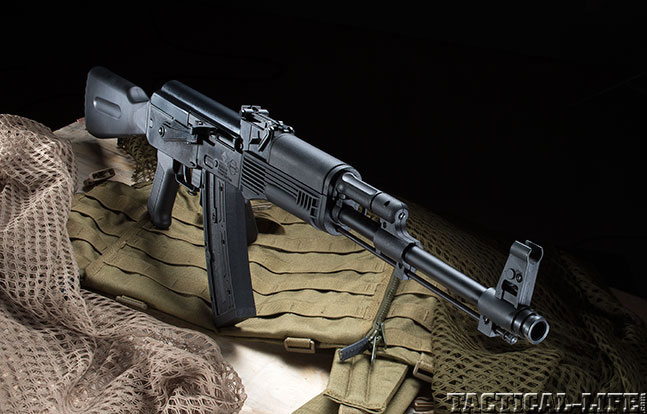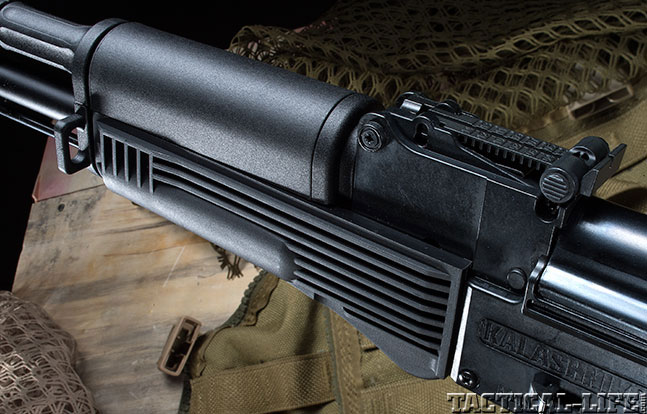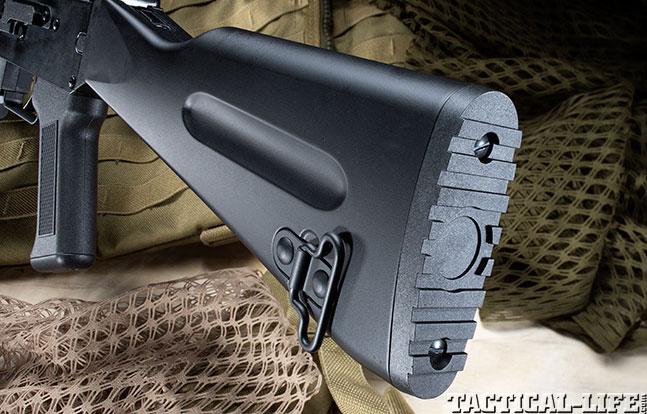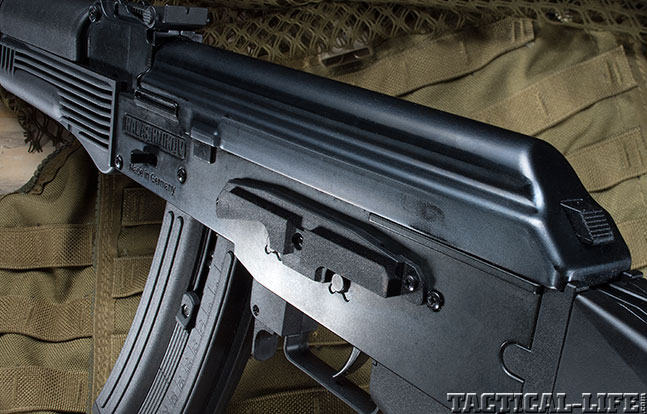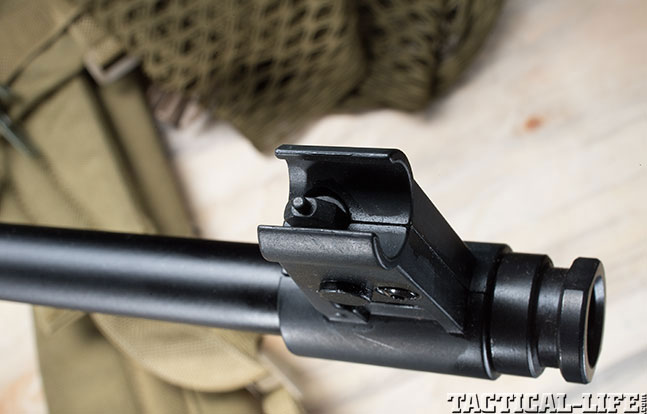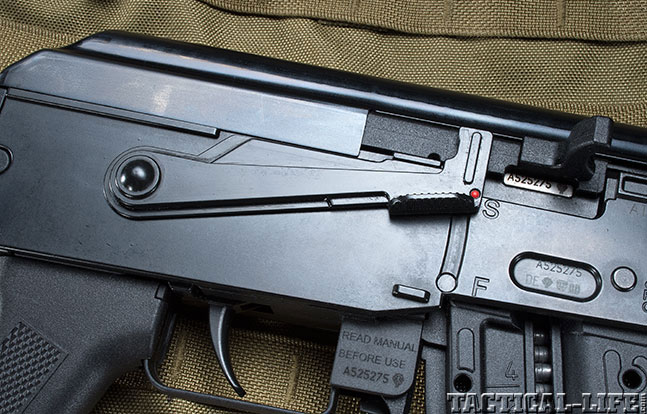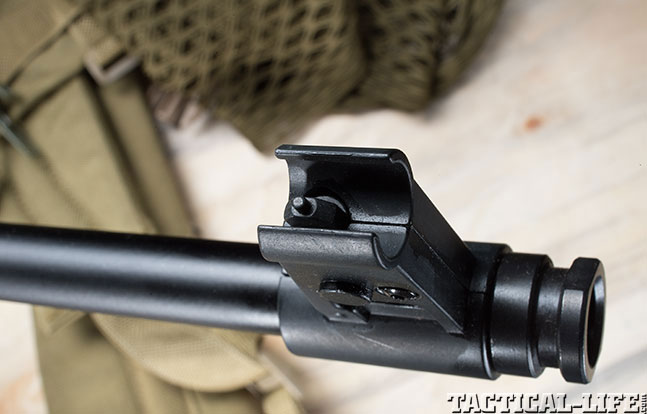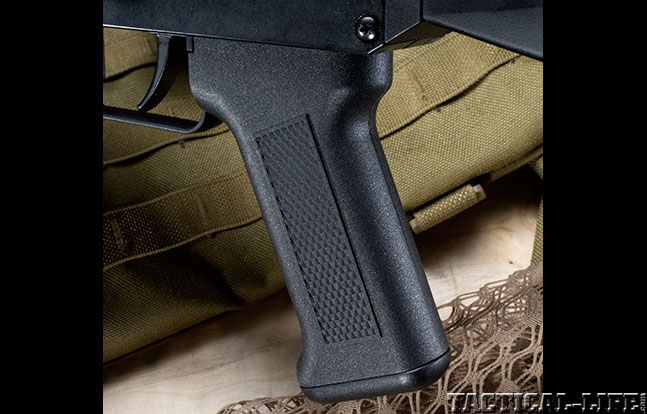American Tactical (AT) has reacted to powerful market forces with one of its offerings—the GSG AK-47 chambered in .22 LR. Many are searching for ways to maintain or increase proficiency without having to spend disproportionate amounts of their individual budgets on centerfire ammunition. The advantage of having an “understudy” rifle chambered in .22 LR and similar in ergonomics and controls to its full-powered sibling is well recognized.
- RELATED: Gun Review: American Tactical’s 5.56 Omni Hybrid
- RELATED: East Meets West: Top 10 Hybrid AK-AR Platforms For 2015
The idea of shooting a .22 LR out of an AR is not a new concept. Various kits are on the market that enable users to substitute bolt carriers into their AR, allowing shooters to benefit from firing the inexpensive .22 LR in full-size ARs for training purposes without having to invest in a new rifle. The same .22 LR concept for an AK is not as simple as switching uppers or selecting from the plethora of .22 LR-chambered ARs on the market. The AT GSG AK-47 .22 LR solves the dilemma.
It makes a lot of sense to introduce a .22 LR-chambered AK rifle. The AK platform is beginning to challenge the AR in terms of popularity here in the U.S. among knowledgeable practitioners of personal security; this is not said to spark controversy, I’m only stating an opinion backed by years of observation in and around the gun culture. While there is no debate that the AR is the best-selling rifle model in America, serious students of personal defense who do not rely on logistical support from a department or agency have come to appreciate what the AK offers in terms of performance. AK simplicity should not be confused with lack of refinement. As experience and knowledge have matured, the reliability and solid performance of the AK have become more entrenched in my mind as the standard.
Advertisement — Continue Reading Below
What more can be written about Mikhail Kalashnikov’s ubiquitous AK? Models/versions proliferate around the world and now are spreading across the land of its Cold War nemesis, the M16/AR-15. Despite the nefarious 1989 import ban and the expired 1994 Assault Weapons Ban, the AK series of weapons have never been as popular in the U.S. as now—either in the AK-47/AKM 7.62x39mm, AK-74 5.45x39mm or Saiga S12 12-gauge variants. The true hallmark of the AK-series of rifles gaining acceptance in the U.S. is the rise of gunsmiths and aftermarket accessories starting to cater to its clientele, as well as variants such as this AT-imported rimfire.
An often-heard knock against the AK is its lack of good ergonomics when compared to most Western designs, such as the AR-15. The atmosphere cultivated in the Soviet Union (indeed, in Russia before and after the Soviet Union), was not one of individual comfort, but rather effectiveness and maximum production.
With that said, many find the standard AK’s pistol grip and stock just fine. Yes, the AK buttstock as it arrives from the factory features a shorter length of pull than its U.S. counterpart. As most realize, this is not a crippling hindrance to effectiveness once explored during training. However, as with most things firearms related, personal preference and opinions will vary with decisions made on what satisfies each individual’s needs. The extra time spent with an understudy weapon such as the AK-47 serves to quicken one’s learning curve in terms of weapon manipulation and operating controls.
Advertisement — Continue Reading Below
Gun Details
AT has brought something original to the U.S. market in the form of the .22 LR AK-47 through a design that began from the ground up to accommodate the .22 LR in a package simulating a full-size AK in terms of weight and balance. AT stresses in its literature that the AK-47 represents much more than a small-caliber “knock-off” of the famous AK. The GSG AK-47 is a rifle featuring quality German engineering and manufacturing that strives to give the end user the same feel as the ever-prolific AK-47 series of weapons. The AK-47 .22 LR appears to be patterned after the updated AK-100 series of rifles.
The AK-100 variants are post-Cold War AKs based on the AK-74 assault rifle. The AK-100 series were born from the AK-74M, which featured polymer-constructed forends and buttstocks. The entire AK-100 series is a family of assault rifles based around standardized parts but with different caliber chamberings—5.56mm, 5.45mm and 7.62x39mm.
Advertisement — Continue Reading Below
The AK-100 assault rifle series uses plastics instead of wood in its construction and uses somewhat higher production standards. Ultimately, they were meant mostly for export instead of domestic use, especially the 5.56mm-chambered variants.
Most of the metal work is of steel with a black phosphate finish. The AK-100 series barrels are cold-hammer forged and tipped with advanced muzzle brakes. Introduced in the 1990s, most AK-100 series rifles produced are the 5.45mm or 7.62x39mm versions. Most of the AK-100 series ended up being used by Airborne, air assault, special operations or VIP-protection units, but perhaps 5,000 or so made it into the international market and, somewhat ironically, were primarily bought by Americans.
Importantly, the AT AK-47 kept AK controls such as the safety, charging handle, magazine-release and bolt-release levers in the same place as 7.62x39mm- and 5.45x39mm-chambered AK rifles. The 17.5-inch-barreled .22 LR AK-47 weighs approximately 7 pounds. The fixed stock gives it an overall length of 36.5 inches.
Advertisement — Continue Reading Below
Features that make the AK popular are present on the .22 LR AK-47 as well, including open sights that replicate the sight picture of standard AKs. Many may not want to utilize the AK-47 as simply an understudy weapon and instead enjoy it as a stand-alone .22 LR in its own right.
GSG’s attention to detail extends to AK-47’s magazine design. The 10-round magazine shipped with the AK-47 is of similar dimensions to standard 30-round AK magazines. This further duplicates the similarity of handling and manual of arms between the AK-47 and centerfire variants. The same web gear and magazine pouches utilized for AK magazines will work for the AK-47 magazine. This model does have a magazine-disconnect safety feature, meaning that a magazine needs to be inserted before the trigger group will fire. However, in my opinion, this is not as big a deal on a rifle chambered in .22 LR as it would be with a rifle chambered in a centerfire caliber more likely to be used in a hostile engagement.
The AK-47 breaks down differently than its centerfire AK sibling due to it being blowback-operated versus gas-operated. A convenient multi-tool is shipped with the rifle to facilitate rear stock mounting, takedown procedures, sight adjustment as well as removing the barrel muzzle nut.
Advertisement — Continue Reading Below
The bolt assembly is a one-piece affair versus the bolt carrier group and recoil spring found on the centerfire variant AK. The top cover is removable, allowing one to see the differences between the .22 LR action and centerfire action. The AK-47 requires the stock to be removed in order to access to the rear trunnion area. Fasteners are removed with the provided multi-tool, facilitating takedown and allowing removal of the pistol grip and blowback bolt group. The GSG manual presents this via detailed instructions.
The only questioning observation I have with the AK-47 is why the muzzle does not have exterior threads that would allow it to be equipped with an AK-style flash suppressor of some type. A screw-in simulated muzzle nut is in place that threads into the sight-block base. However, an exterior-threaded barrel would have enabled shooters an easy method to mount a suppressor on the AK-47, if so desired.
At The Range
Advertisement — Continue Reading Below
Range visits further sealed my original good impression of the AK-47. This AK does everything a .22 LR should do, such as provide solid accuracy and reliable semi-automatic fire, enhancing the marksmanship capabilities of shooters of all skill levels. AT takes this one step further with the AK-47 through enabling it to serve as an understudy to its centerfire AK brethren.
Range testing consisted of normal firing from the bench for accuracy assessment of CCI AR Tactical 40-grain, Federal AutoMatch 40-grain and CCI Mini-Mag 36-grain HP (hollow-point) loads. Groups at 25 yards were in the 1-inch area, and 3 inches at 50 yards. This is more than accurate enough for a rifle meant to be shot from standing, kneeling or similar shooting positions away from the bench using AK-pattern open sights. The AK-47 also has an AK side-rail scope mount if a user wants to mount a magnified optic or red-dot sight.
The AK-47 can fall in line with the traditional .22 LR role of introducing new shooters to the sport. Trigger control and steady hold can be perfected with the minimal recoil and blast associated with .22 LR. Proper sight alignment and trigger control are also easy to self-diagnose with the .22 LR. The economic advantages of the .22 LR are again a major plus; inexperienced shooters can afford to practice much longer with the .22 LR.
Advertisement — Continue Reading Below
The AK-47 has the added benefit of training shooters of all skill levels in AK manipulation techniques. The low cost of shooting .22 LR ammunition is attractive, but not at the expense of an unfamiliar rifle with awkward controls and an uncertain reliability aspect, an issue only compounded by not getting any training value out of range time with your primary weapon. Fortunately for those who like military rifles, all of these issues were not a factor with the AK-47. The look, feel and controls are nearly identical to its popular big brother. From the first time the AK-47 was handled, it was noted that the shooter had the same feel as if shooting an AK-47 or AK-74. Whether it is for low-cost realistic training or to help a youngster learn to handle this style, the AK-47 will make a nice addition to any firearms collection.
For more information, visit americantactical.us or call 800-290-0065.
